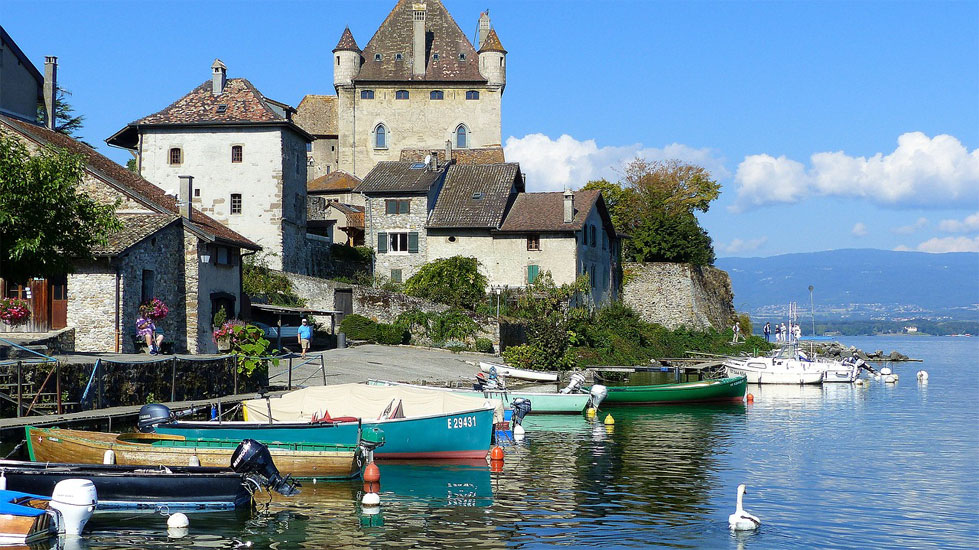Yvoire is a small medieval village in the department of Haute Savoie in the Rhone-Alpes region in southeastern France. ( on the French coast of Lake Geneva ) The strategic location of Ivoire on the border between the “small” and “large” lakes Leman (Lake Geneva in French) was decided to use the Duke of Savoy Amedeus V the Great in 1306, having built a citadel on the shore. For half a century, the town played an important military role, which allowed local residents to get rid of paying taxes in 1324.
Later, when the entire region was occupied by the Berne forces in 1536–91, the city lost its military status, and the fortress wall surrounding it was demolished. The castle was burned and for 350 years remained without a roof. Over a long period, Ivoire has become a militarily insignificant village of farmers and fishermen.
Since 1950, with the development of tourism, Ivoire began to revive. In 1959, he first received the national Flower Prize.
Many ancient buildings have survived: walls, gates, moats, houses. Since the end of World War II, agriculture and fisheries are gradually disappearing; tourism occupies the main niche. People gradually decorate their homes with flowers. In 1959, Ivoire first won the competition of flower cities and villages
. Over the years, he has been one of the winners in national floristry contests (1992, 1995, 1998, 2001, 2007). In summer, Ivoire is filled with a huge number of flowers, but as a rule, flowering continues throughout all seasons. For more than 20 years, the city has been part of the prestigious association of the most beautiful villages in France. In 2006, Ivoire celebrated its 700th anniversary.
Due to its beauty and tourist attraction, it is one of the towns classified as Les plus beaux villages de France.- most beautiful villages in France.Today attracts many tourists resting on the shores of the lake in France and Switzerland.
Access : Coordinates: 46.370279, 6.326153 / It is located on the French coast of Lake Geneva, 27 kilometers from Geneva. The most convenient way to get there is by car – along the D1005 road, then turn onto D25. / Also, if you travel without a car, you can sail to Ivoire by boat directly from Geneva or from the Swiss Nyon, located on the Swiss coast directly opposite the “most beautiful village of France”.
Highlights :
- Saint-Pancrace Church : The current tower was built in 1854 with a bow-shaped dome, typical of the religious buildings of Savoy and Piedmont at the end of the 19th century. Initially, the dome was covered with iron plates, which were badly damaged by rust. In 1989, they were replaced with stainless steel plates.
- Ivoire Castle (Chateau d’Yvoire) : The castle was located on a ledge towering above Lake Geneva, in the place of an ancient fortress. Surrounded by a fortified city, the castle made it possible to control the movement of ships on Lake Geneva between its small and large parts, between Geneva and Italy..The castle is closed to visitors, but you can see the beautiful garden
- Labyrinth in the Garden of Five Senses : Located in the center of Ivoire, this garden was created in 1988 on the site of the former castle garden. This garden is part of the association Jardin remarquable de France (“noteworthy gardens of France”). It covers an area of 2500 square meters. meters. Its center is a small cloister, where medical and aromatic herbs grow, and in the center there is a small fountain surrounded by bird houses, roses and fruit trees.
- Porte de geneve : This is not much that survived after the demolition of the fortress wall surrounding Ivoire by the Berne forces that occupied Lake Geneva in the 16th century. The gate was added to the list of historical monuments in 1943..
- Porte de thonon : Gates of Thonon, preserved from the medieval fortress wall surrounding the city, were included in the list of historical monuments in 1981.
- The village of Ivoire is rightly called the “pearl of Lake Geneva.”This name is connected not so much with its location, but with the architecture and atmosphere of the village itself.
Activities : sightseeing / photo opportunities / trekking
Go next : Lake Geneva is the largest lake in the Alps and the second largest freshwater lake in Central Europe.

